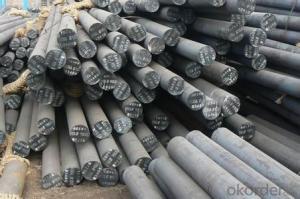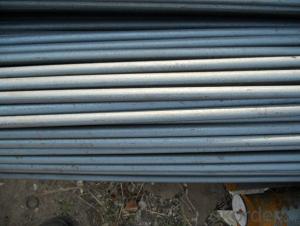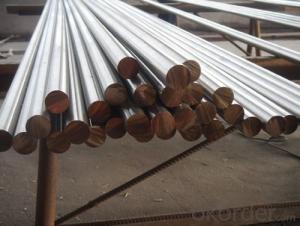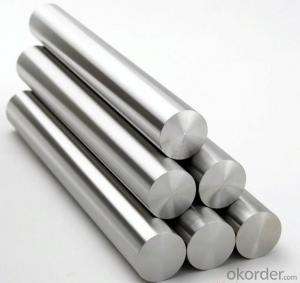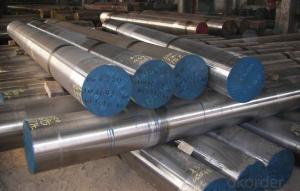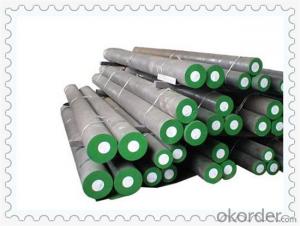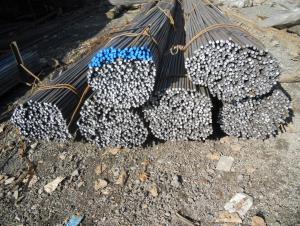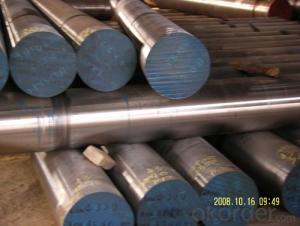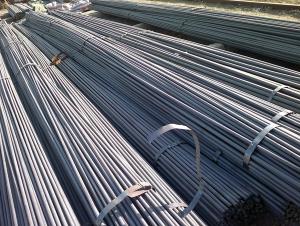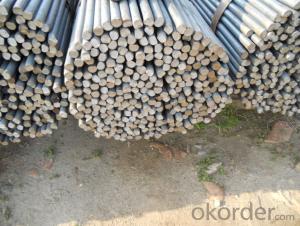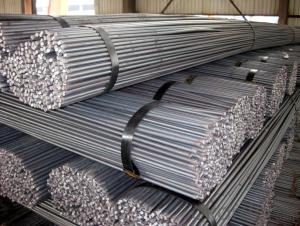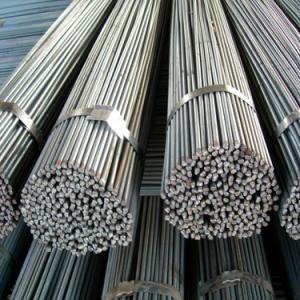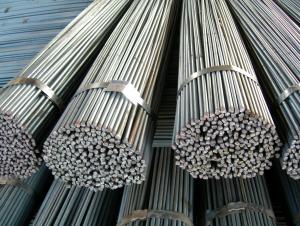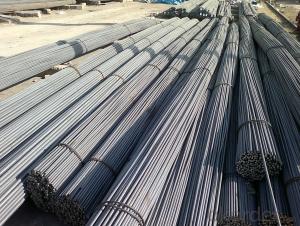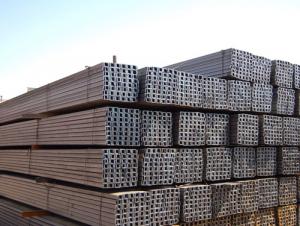cold round bar and gb
- Loading Port:
- China Main Port
- Payment Terms:
- TT OR LC
- Min Order Qty:
- -
- Supply Capability:
- -
OKorder Service Pledge
OKorder Financial Service
You Might Also Like
Product Description:
Specifications of Wire Rod Q235:
Steel Grade: Q235, Standard: GB Diameter: 5.5mm, 6.5mm, 7mm,8mm,9mm,10mm,12mm,14mm
Diameter Tolerance:±0.3mm 6.5mm can be drawing into 2mm/8.0mm can be drawing into 3mm
:
Please kindly find our chemistry of our material based on Q235 as below for your information
Trademark | Rank | Chemical composition (quality score) % | | ||||
C | Si | Mn | S | P | | ||
| | |||||||
| ≤ |
| ≤ | ≤ | | ||
Q235 | A | 0.14-0.22 | 0.30 | 0.30-0.65 | 0.050 | 0.045 | |
Q235 | B | 0.12-0.20 | 0.30 | 0.30-0.70 | 0.045 | 0.045 | |
Trademark | Rank | Pulling Test | | ||||
Bend PointΔs/Mpa | Tensile Strength | Elongation Ratioδ5% | | ||||
| | |||||||
Thickness (Diameter) /MM | Thickness (Diameter) /MM | | |||||
≤16 | 16-40 | | ≤16 | 16-40 | | ||
≥ | | ≥ | | ||||
Q235 | A | 235 | 225 | 375-500 | 26 | 25 | |
Q235 | B | 235 | 225 | 375-500 | 26 | 25 | |
Usage and Applications of Wire Rod Q235:
After hot-rolled the products shaped into coil and delivery as finished product, including round, square, rectangular, hexagonal and so on. Since most of the products are round, it is generally called wire rod. Carbon steel wire rod is widely used in construction and manufacturing. Carbon steel wire rod is mainly used for reinforcement of reinforced concrete and welded structure or reprocessed (roberts , nail, etc.) materials, especially used to produce wire drawing, welding electrode, nails, spring, electronic, precise machinery parts and so on.
Packaging & Delivery of Wire Rod Q235:
Packaging Detail: products are packed in coil and then shipped by container or bulk vessel
Each coil weight: 2-3MT
Delivery Detail: within 45 days after received deposit or LC.
Label: to be specified by customer, generally, each bundle has 1-2 labels
Trade terms: FOB, CFR, CIF
- Q: Can steel round bars be used for making handrails?
- Indeed, handrails can be crafted using steel round bars. Owing to their robustness and longevity, steel round bars find widespread usage in construction and fabrication. These bars can be effortlessly molded and joined together through welding techniques, resulting in handrails that furnish support and ensure safety for staircases, balconies, and elevated spaces. Furthermore, steel round bars can be adorned with a variety of coatings or treatments, augmenting their resistance to corrosion and enhancing their visual appeal. In summary, steel round bars are a favored option for fabricating handrails due to their durability, adaptability, and capacity to endure rigorous utilization.
- Q: What are the advantages of using tool steel round bars?
- Tool steel round bars offer several advantages: 1. High hardness: Tool steel round bars have exceptional hardness, making them ideal for applications that require resistance to wear, abrasion, and deformation. This property ensures longevity and durability of the tool. 2. Excellent machinability: Tool steel round bars are known for their excellent machinability, meaning they can be easily shaped, cut, and formed into various tool designs. This enhances the versatility and precision of the tool. 3. Superior strength and toughness: Tool steel round bars possess exceptional strength and toughness, enabling them to withstand high impact and shock loading. This makes them suitable for heavy-duty applications where tools are subjected to intense pressure and stress. 4. Good heat resistance: Tool steel round bars exhibit excellent heat resistance, allowing them to retain their hardness and strength even at high temperatures. This characteristic is crucial for tools used in applications involving heat treatment, forging, and molding. 5. Corrosion resistance: Many tool steel alloys contain elements such as chromium, vanadium, and molybdenum, which enhance their corrosion resistance. This makes tool steel round bars suitable for applications in corrosive environments, ensuring longevity and performance. 6. Precise dimensional accuracy: Tool steel round bars are manufactured to precise dimensional tolerances, ensuring uniformity and consistency in their shape and size. This level of accuracy is crucial for ensuring the proper fit and functionality of the tool. Overall, the advantages of using tool steel round bars lie in their hardness, machinability, strength, heat resistance, corrosion resistance, and dimensional accuracy, making them a preferred choice for various tooling applications.
- Q: Are steel round bars suitable for outdoor sculptures?
- Indeed, outdoor sculptures can be made with steel round bars. Steel, being a resilient and robust substance, can endure severe weather conditions, including rain, snow, and extreme temperatures. It possesses resistance against corrosion, making it an ideal option for outdoor applications. The malleability of steel round bars allows for effortless shaping and welding, enabling the creation of intricate and elaborate sculptures. Furthermore, steel can be coated with diverse finishes, such as powder coating or paint, to provide additional protection against the elements and enhance its aesthetic appeal. In summary, steel round bars offer the requisite strength, durability, and adaptability necessary for outdoor sculptures.
- Q: Can steel round bars be painted?
- Steel round bars can indeed be painted in order to protect them from corrosion and improve their appearance. However, prior to painting, it is crucial to properly prepare the surface of the steel round bars by thoroughly cleaning, degreasing, and eliminating any rust or mill scale. This can be accomplished through various methods such as sandblasting, wire brushing, or chemical cleaning. Once the surface is adequately prepared, it is necessary to apply a primer specifically formulated for steel to enhance the adhesion of the paint. Subsequently, the desired paint can be applied to the steel round bars using brushes, rollers, or spray equipment. It is essential to select a paint that is suitable for outdoor use and offers ample protection against harsh weather conditions. To ensure the long-lasting durability of the painted steel round bars, regular maintenance and periodic repainting may be necessary.
- Q: Can steel round bars be used for valve stem applications?
- Yes, steel round bars can be used for valve stem applications. Steel round bars are often used in various industrial applications, including valve stems, due to their strength, durability, and resistance to corrosion.
- Q: What are the different types of steel round bars used in the automotive braking systems?
- Automotive braking systems rely on various types of steel round bars that possess specific properties for optimal performance. These steel variants are carefully selected for their strength, durability, and ability to withstand the intense temperatures and pressures that arise during braking. One commonly utilized steel round bar is carbon steel, renowned for its exceptional hardness and high strength. Brake rotors and drums often incorporate carbon steel round bars due to their ability to endure the heat and friction generated during braking, ensuring reliable and long-lasting performance. Stainless steel represents another steel round bar employed in automotive braking systems. Its resistance to corrosion and rust make it an ideal choice for brake lines and fittings. Additionally, stainless steel boasts excellent heat resistance properties, enabling it to endure the thermal stresses generated during braking. Furthermore, alloy steel round bars find application in automotive braking systems. Combining various metals like chromium, nickel, and molybdenum, alloy steel enhances its mechanical properties. Known for their remarkable tensile strength and toughness, alloy steel round bars suit demanding applications that require superior performance and durability. Specialized types of steel round bars also exist, designed specifically for particular applications within automotive braking systems. For instance, heat-treated steel round bars are employed in the manufacturing of brake calipers and pistons due to their capability to withstand the extreme temperatures resulting from the friction between brake pads and rotors. In summary, the selection of steel round bars in automotive braking systems hinges upon specific requirements, encompassing strength, durability, heat resistance, and corrosion resistance. By carefully choosing the appropriate steel variant, automotive manufacturers can guarantee the safety and reliability of their braking systems.
- Q: Can steel round bars be machined?
- Yes, steel round bars can be machined. Machining is a process that involves the removal of material from a workpiece to create the desired shape, size, or finish. Steel round bars are commonly machined to create various components, such as shafts, bolts, and fasteners. Machining processes such as turning, milling, drilling, and grinding can be used to shape and cut the steel round bars. However, the machinability of steel can vary depending on factors such as the composition and hardness of the steel, cutting tools, and machining parameters. It is important to use appropriate machining techniques and tools to ensure accurate and efficient results while machining steel round bars.
- Q: What are the different types of steel round bars used in the automotive aftermarket?
- There are several different types of steel round bars used in the automotive aftermarket, including carbon steel, alloy steel, and stainless steel. These bars are commonly used for various applications such as suspension systems, drivetrain components, and chassis reinforcement. The specific type of steel round bar used depends on the desired strength, durability, and corrosion resistance for the particular automotive part.
- Q: What are the advantages of using steel round bars compared to other materials?
- Steel round bars offer several advantages over other materials. Firstly, steel is known for its exceptional strength and durability. With its high tensile strength, steel can withstand heavy loads and pressure without deforming or breaking. This makes steel round bars perfect for applications that require structural support or load-bearing capabilities. Furthermore, steel is a highly versatile material that can be easily shaped and molded into various forms, including round bars. This flexibility in design makes steel round bars suitable for a wide range of applications, whether it be in construction, manufacturing, or the automotive industry. They can be customized to meet specific requirements. In addition to its strength and versatility, steel is also corrosion-resistant. It naturally resists rust and other forms of corrosion, making it ideal for both indoor and outdoor use. Steel round bars can withstand exposure to moisture, chemicals, and harsh environmental conditions, ensuring their longevity. Another advantage of steel round bars is their cost-effectiveness. Although the initial cost of steel may be higher than that of other materials, its long-term benefits and durability make it a cost-effective choice. Steel round bars require minimal maintenance and can last for decades without the need for replacement or repair, resulting in significant cost savings over time. Moreover, steel is a sustainable material. It is 100% recyclable and can be reused multiple times without losing its properties or quality. By choosing steel round bars, one contributes to reducing waste and conserving resources, making it an environmentally friendly choice. In conclusion, the strengths of steel round bars compared to other materials lie in their strength, versatility, corrosion resistance, cost-effectiveness, and sustainability. These qualities make steel round bars the preferred choice for various applications, guaranteeing long-lasting and reliable performance.
- Q: Can steel round bars be used for making body panels?
- Yes, steel round bars can be used for making body panels. Steel is a commonly used material in the automotive industry due to its strength, durability, and formability. Round bars can be shaped, welded, and formed into various body panel shapes, providing structural support and protection. However, it's important to note that steel round bars might not be the ideal choice for all body panels, as they can be heavier compared to alternative materials such as aluminum or carbon fiber. The decision to use steel round bars for body panels depends on factors such as the specific vehicle application, desired weight reduction, and cost considerations.
Send your message to us
cold round bar and gb
- Loading Port:
- China Main Port
- Payment Terms:
- TT OR LC
- Min Order Qty:
- -
- Supply Capability:
- -
OKorder Service Pledge
OKorder Financial Service
Similar products
Hot products
Hot Searches
Related keywords
